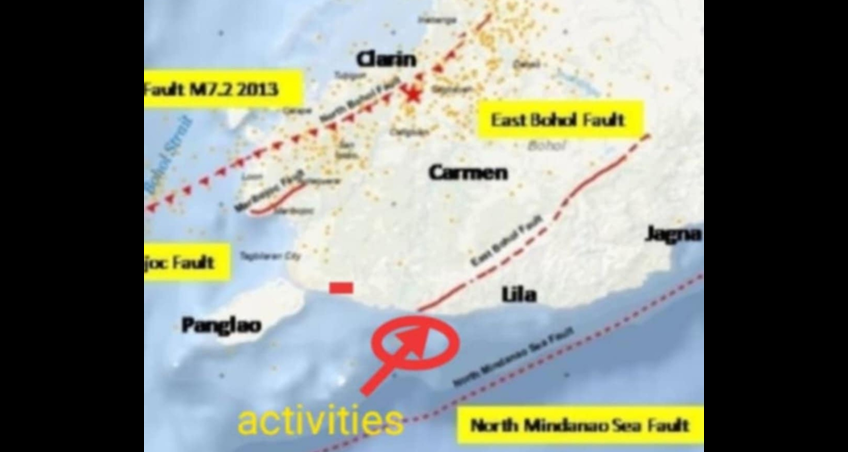NOTE: THIS STORY WAS FIRST PUBLISHED IN THE BOHOL CHRONICLE’S SUNDAY PRINT EDITION.
The East Bohol Fault, one of the four fault lines in the province, is closely being monitored following the successive 27 mild tremors in three towns during the past two months.
This fault line’s projected energy release will be Magnitude 7, according to Nolan Evangelista, Science Research Analyst who is designated as officer-in-charge of the Philippine Institute of Volcanology and Seismology (PHIVOLCS) office here.
The intensified monitoring followed after the 27 tremors excluding the recent five tremors in the Loay area.
There were 12 seismic events in Anda town, 11 in the Loay-Lila area and four in Sierra Bullones.
Aside from the East Bohol Fault, there are three other fault lines in the province, namely North Bohol Fault, South Offshore Fault and the Maribojoc Fault.
Of the four faults, the East Bohol Fault places the province on a “critical watch” considering that this fault has not recorded major movements during the past 100 years.
This fault line stretches from Loay to Sierra Bullones.
The Phivolcs official said if this fault makes a major movement, the tremor will be felt in the coastal areas from Tagbilaran to Valencia and the interior towns of Sevilla, Loboc as well as Corella and Cortes towns.
It may be recalled that the strongest earthquake to hit the province was at intensity 7.2 on October 15, 2013, some 11 years ago. The origin of the tremor was traced to the North Bohol Fault which fault line stretches across from Inabanga town to Oslob, Cebu.
The tremor felt in Loay was traced to be coming between the East Bohol Fault and the South Offshore Fault while the one in Mabini town was from the South Offshore Fault.
The very mild tremors in Pilar and Sierra Billones were traced to be coming from the tail end of the North Bohol Fault.
Phivolcs said the Maribojoc Fault is at the foot of the Maribojoc mountain while it is observed to be a shorter fault. However the study of the Maribojoc Fault is still at its infancy level while more facts are being needed for a conclusive report of its status and projected energy release.
HIGH RISK POSSIBILITY
The movement of the East Bohol Fault is positioned on a “high risk possibility” considering that this fault line has not recorded strong tremors during the past 100 years.
Meanwhile, the strongest quake to hit Bohol was a 7.2 earthquake in 2013 leaving no less than 200 people dead while 350,000 people displaced. Some 50,000 homes were destroyed.
Most of the quake epicenters that plot in Bohol are related to deep focus earthquakes associated with the eastward subduction of the Philippine Sea plate.
Bohol was hit by a 6.8 tremor in 1990 with Panda as its epicenter and another in 1996 at magnitude 5.6.
CAPITOL CONDUCTS EVACUATION DRILL
The provincial government initiated a mass casualty management simulation exercise (Simex) at the New Bohol Provincial Capitol Grounds last Friday from 10 a. m. to 12 noon.
The simulation is part of ongoing efforts to strengthen Bohol’s disaster preparedness and emergency response capabilities, given the province’s vulnerability to both natural disasters and man-made emergencies such as typhoons, earthquakes, and flooding, and possible natural threats, which may include bombings, fires, and vehicular accidents that pose serious risks to public safety.
Recognizing these dangers, the provincial government of Bohol, under the leadership of Governor Aris Aumentado, conducted a simulation to address the gaps identified in the province’s emergency management system.
This initiative aims to improve coordination among responders, in line with the Capitol’s Strategic Agenda on environmental sustainability, resiliency, and disaster preparedness.
The exercise simulated large-scale emergencies, including bombing and fire, with participants from various agencies such as the Philippine National Police (PNP), Bureau of Fire Protection (BFP), Armed Forces of the Philippines (AFP), and the Provincial Disaster Risk Reduction and Management Office (PDRRMO).
Other organizations, including the Office of Civil Defense (OCD), Department of Health (DOH), Bureau of Quarantine (BOQ), and the City and Municipal Disaster Risk Reduction and Management Offices (CDRRMO and MDRRMO) of Corella and Dauis, also took part.

